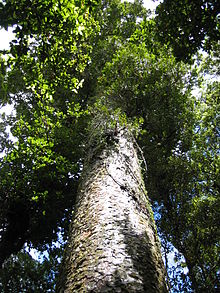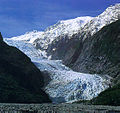New Zealand flora and vegetation

The flora and vegetation of New Zealand was due to the isolated location of New Zealand and the expansion of the islands over 14 degrees of latitude than in its diversity unique flora develop.
Geographical requirements
Until about 200 million years ago, New Zealand - like most of the land masses in the southern hemisphere today - belonged to the primary continent Gondwana . The exact point in time is not certain, but at the latest 85 million years ago, i.e. in the Upper Cretaceous Period , Zealandia and thus today's New Zealand separated from the land mass that now forms Antarctica , before today's Australia separated from this supercontinent. Since then, a flora and fauna independent of all other land areas has developed in New Zealand .
During the Oligocene , the land area was reduced to small islands that barely protruded from the sea. Volcanism can be found there to this day .
biodiversity
Approximately 85% of the approximately 2,300 native plant species in New Zealand are considered endemic , meaning that they only occur there. Even so, there is no endemic plant family in New Zealand, but there are 35 endemic genera . Except for the genus Raoulia with 35 species and the genus Hoheria with 5 species, the remaining endemic genera comprise only about one to three species.
Furthermore, floristic centers with high proportions of local endemics can be identified on the two main islands: the northern part of the North Island with approx. 125 endemic plant species and the northern and southern part of the South Island with approx. 190 and 120 local endemics, respectively. This can be explained by the higher geological age of these regions. The gaps in between lay below sea level during the Pliocene and up to the younger Pleistocene or were separated from one another by mountain ranges.
A decisive break in the flora of the islands was the settlement by humans. Although it only began about 1000 years ago, the vegetation has changed fundamentally since then and there are about as many introduced and native plant species.
Floral relationships
The coniferous forests in the north with many epiphytes are somewhat reminiscent of the forests in New Guinea , approx. 4000 kilometers northwest of New Zealand, while the southern beech forests in cooler regions are comparable to those in Chile 9000 kilometers east . The Tussock -Graslandschaften the intramontane pool and above the tree line can be found even in the high mountains of the country.
Ecological adjustments
In addition to a high degree of endemism and the variety of climatic zones, the New Zealand flora has some peculiar characteristics. Only a few species are annual , and nitrogen fixation is rare. The majority of the species is evergreen , and dioecus is also very common. Another common feature is a so-called “filiramulate” growth habit, in which bushes are very small-leaved, but branch out many times and densely. Only a few tree species are cold-resistant. Bird dispersal is a very common trait, with no adjustments to grazing or fire. Flowers are usually inconspicuous, white and small.
vegetation
New Zealand has a large number of different vegetation zones . The climatic conditions range from subtropical in the north to cool and temperate - alpine in the south, accordingly different habitats can be found. There are several reasons for this diversity. On the one hand, over 1,600 km north-south extension is extremely long compared to the relatively small land area, Germany is only about 880 km long for comparison with a land area of 357,000 km². Another important reason for the large number of vegetation zones are the great differences in altitude in New Zealand, from sea level to the 3754 meter high summit of Aoraki / Mount Cook . Although Australia, for example, is over 28 times larger than its "little neighbor", its highest point, Mount Kosciuszko , is only 2228 meters high. Last but not least, the uneven distribution of precipitation due to the location of the mountains also ensures a variety of vegetation zones.
While almost the entire west coast of the South Island is covered with dense temperate rainforest , the Southern Alps belong to the alpine vegetation zone. The proximity of these completely different zones is unusual. The most famous glaciers are the Franz Josef, Fox and Tasman glaciers . Intensive agriculture is practiced in the plains, while extensive pasture farming predominates in many other places. To the east of the central plain, the landscape is shaped like a steppe due to the low rainfall . The northern parts of the North Island are located in the subtropical vegetation zone and are largely covered with rainforest in less populated places .
Mangrove forests , mangrove trees of the species Avicennia marina var. Resinifera .
Steppe-like vegetation: Castle Hill , South Island
Subtropical Vegetation Zone: The Waitakere Ranges
Rainforest meets glacier: the Franz Josef Glacier
Extensive beaches in Kahurangi National Park
Web links
literature
- Peter Wardle: Vegetation of New Zealand . - Cambridge University Press, 1991
- John Dawson & Rob Lucas: Nature Guide to the New Zealand Forest . - Godwit, 2000
- HH Allan et al .: Flora of New Zealand Vol. IV . - Manaaki Whenua Press, 1982-1999 (online version of the Flora of New Zealand)
- MS McGlone: Plant biogeography and the late Cenozoic history of New Zealand. - New Zealand Journal of Botany, 23: 723-749 (1985).
Individual evidence
- ^ MS McGlone: Plant biogeography and the late Cenozoic history of New Zealand. - New Zealand Journal of Botany, 23: 723-749 (1985)





